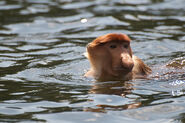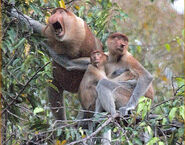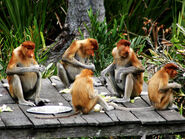
Male Proboscis Monkey

Female Proboscis Monkey
The proboscis monkey (Nasalis larvatus) or long-nosed monkey, known as the bekantan in Indonesia, is a reddish-brown arboreal Old World monkey that is endemic to the southeast Asian island of Borneo. This species co-exists with the Bornean orangutan. It belongs in the monotypic genus Nasalis, although the pig-tailed langur has traditionally also been included in this genus. The monkey also goes by the Indonesian name monyet belanda ("Dutch monkey"), or even orang belanda ("Dutchman"), as Indonesians remarked that the Dutch colonisers often had similarly large bellies and noses. This species of monkey is easily identifiable because of its unusually large nose.
The proboscis monkey is a large species, being one of the largest monkey species native to Asia. Only the Tibetan macaque and a few of the gray langurscan rival its size. Sexual dimorphism is pronounced in the species. Males have a head-body length of 66 to 76.2 cm (26.0 to 30.0 in) and typically weigh 16 to 22.5 kg (35 to 50 lb), with a maximum known weight of 30 kg (66 lb). Females measure 53.3 to 62 cm (21.0 to 24.4 in) in head-and-body length and weigh 7 to 12 kg (15 to 26 lb), with a maximum known mass of 15 kg (33 lb). Further adding to the dimorphism is the large nose or proboscis of the male, which can exceed 10.2 cm (4.0 in) in length, and hangs lower than the mouth. Nevertheless, the nose of the female is still fairly large for a primate. The proboscis monkey has a long coat; the fur on the back is bright orange, reddish brown, yellowish brown or brick-red. The underfur is light-grey, yellowish, or greyish to light-orange. The face is orange-pink. The male has a red penis with a black scrotum. Both sexes have bulging stomachs that give the monkeys what resembles a pot belly. Many of the monkeys' toes are webbed for swimming.
Social Behavior[]
Proboscis monkeys generally live in groups composed of one adult male, some adult females and their offspring. All-male groups may also exist. Some individuals are solitary, mostly males. Monkey groups live in overlapping home ranges, with little territoriality, in a fission-fusion society, with groups gathering at sleeping sites as night falls. There exist bands which arise when groups come together and slip apart yet sometimes groups may join to mate and groom. Groups gather during the day and travel together, but individuals only groom and play with those in their own group. One-male groups consist of 9–19 individuals, while bands can consist of as many as 60 individuals. One-male groups typically consist of three to 12 individuals, but can contain more. Serious aggression is uncommon among the monkeys but minor aggression does occur. Overall, members of the same bands are fairly tolerant of each other. A linear dominance hierarchy exists between females. Males of one-male groups can stay in their groups for six to eight years. Replacements in the resident males appear to occur without serious aggression. Upon reaching adulthood, males leave their natal groups and join all-male groups. Females also sometimes leave their natal groups, perhaps to avoid infanticide or inbreeding, reduce competition for food, or elevation of their social status.
Reproduction[]
Females become sexually mature at the age of five years. They experience sexual swelling, which involves the genitals becoming pink or reddened. At one site, matings largely take place between February and November, while births occur between March and May. Copulations tend to last for half a minute. The male will grab the female by the ankles or torso and mount her from behind. Both sexes will encourage mating, but they are not always successful. When soliciting, both sexes will make pouted faces. In addition, males will sometimes vocalize and females will present their backsides. Mating pairs are sometimes harassed by subadults. Proboscis monkeys may also engage in mounting with no reproductive purpose, such as playful and same-sex mounting. Gestation usually last 166–200 days or slightly more. Females tend to give birth at night or in the early morning. The mothers then eat the placenta and lick their infants clean. The young begin to eat solid foods at six weeks and are weaned at seven months old. The nose of a young male grows slowly until reaching adulthood. The mother will allow other members of her group to hold her infant. When a resident male in a one-male group is replaced, the infants are at risk of infanticide.
Communication[]
Proboscis monkeys are known to make various vocalizations. When communicating the status of group, males will emit honks. They have a special honk emitted towards infants, which is also used for reassurance. Males will also produce alarm calls to signal danger. Both sexes give threat calls, but each are different. In addition, females and immature individuals will emit so-called "female calls" when angry. Honks, roars and snarls are made during low-intensity agonistic encounters. Nonvocal displays include leaping-branch shaking, bare-teeth open mouth threats and erection in males, made in the same situations.
















